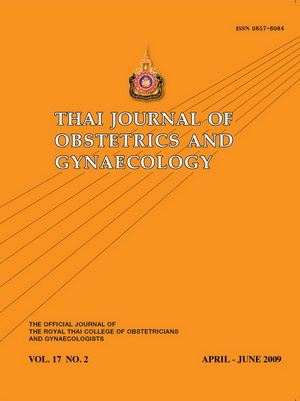Risk of Low Birth Weight and Adverse Pregnancy Outcomes in Adolescent Pregnancies at Chainat Hospital
Main Article Content
Abstract
Objective:
To compare maternal and neonatal outcomes between adolescent and adult pregnancy, focused on the risk of low birth weight (LBW) infants.
Study design:
Retrospective study.
Materials and Methods:
A total cases of 594 from 625 pregnant women that delivered at Chainat Hospital between June 1 and November 30, 2008 were recruited in this study. Two groups were divided by aged, 259 cases aged below 20 years old and 335 cases aged between 20-25 years old. The demographic, obstetric and neonatal outcomes data were collected from all relevant inpatient records and were reviewed and compared between two groups. The statistical analysis used were unpaired student’s t-test and Pearson Chi-square test.
Results:
The adolescent mothers had significant lower mean hematocrit than the adult mothers (mean 34.7 ± 3.7 % and 35.5 ± 3.5 %, p=0.005). The adolescent group had significant higher risk of preterm birth (RR 2.31, CI 1.25 -4.24, p=0.006) and LBW infants (RR 1.96, CI 1.16 -3.31, p= 0.010). The maternal aged between 13-16 years had the highest elative risk of LBW infants (RR 2.49, CI 1.19 -5.21, p= 0.013 ).
Conclusion:
Adolescent pregnancy is one of the risk factor of LBW infants and preterm delivery.

